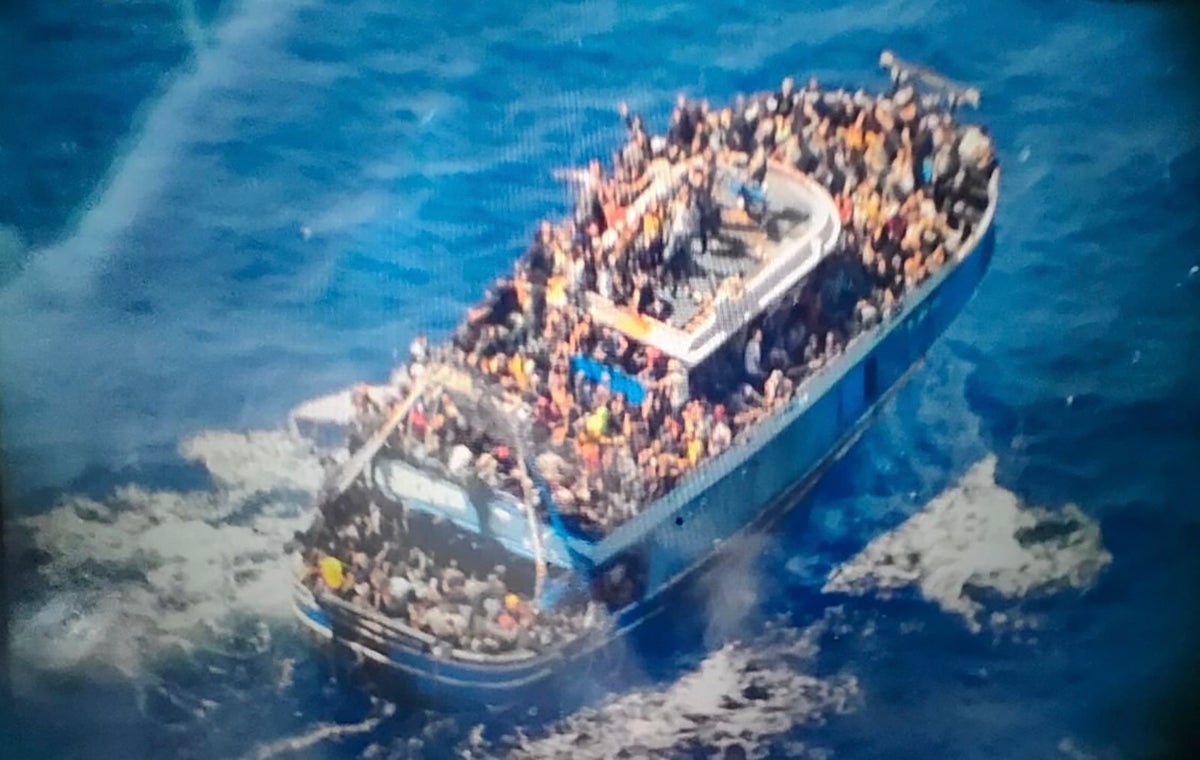
This much is clear: On June 9, an old steel fishing trawler left eastern Libya for Italy, carrying far too many people.
As many as 750 men, women and children from Syria, Egypt, Palestine and Pakistan were on board, fleeing hopelessness in their home countries and trying to reach relatives in Europe.
Five days later, the trawler sank off the coast of Greece in one of the deepest parts of the Mediterranean Sea, in what is likely one of the deadliest shipwrecks in recent Mediterranean history. Only 104 people, all men, survived. The remains of 78 people were recovered.
There are still more questions than answers about what led up to one of the worst shipwrecks in recent Mediterranean history.
Activists, migration experts and opposition politicians have criticized Greek authorities for not acting earlier to rescue the migrants, even though a coast guard vessel escorted the trawler for hours and watched helplessly as it sank.
Below is a timeline of events based on reports from Greek authorities, a commercial ship, and activists who said they were in touch with passengers. They describe sequences of events that at times converge, but also differ in key ways.
The Greek Coast Guard said that the overcrowded trawler was moving steadily toward Italy, refusing almost all assistance, until minutes before it sank. This is in part supported by the account of a merchant tanker that was nearby.
But activists said that people on board were in danger and made repeated pleas for help more than 15 hours before the vessel sank.
International maritime law and coast guard experts said that conditions on the trawler clearly showed it was at risk, and should have prompted an immediate rescue operation, regardless of what people on board may have said.
Much of these accounts could not immediately be independently verified.
Missing from this timeline is the testimony of survivors, who have been transferred to a closed camp and kept away from journalists.
All times are given in Greece’s time zone.
FIRST CONTACT
Around 11 a.m. on Tuesday, Italian authorities informed Greece that a fishing trawler packed with migrants was in international waters southwest of the Peloponnese. Greece said the Italian authorities were alerted by an activist.
Around the same time, human rights activist Nawal Soufi wrote on social media that she had been contacted by a woman on a boat that had left Libya four days earlier.
The migrants had run out of water, Soufi wrote, and shared GPS coordinates through a satellite phone showing they were approximately 100 km (62 miles) from Greece.
“Dramatic situation on board. They need immediate rescue,” she wrote Tuesday morning.
Over the course of the day, Soufi described some 20 calls with people on the trawler in a series of social media posts and a later audio recording. The Associated Press could not reach Soufi.
A surveillance aircraft from the European Border and Coast Guard Agency Frontex spotted the overcrowded trawler at 12:47 p.m. and notified Greek authorities. Frontex declined to share any more information.
DIFFERING ACCOUNTS OF CONDITIONS ON BOARD
At 2 p.m., Greek authorities established contact with someone on the trawler. The vessel “did not request any assistance from the Coast Guard or from Greece,” according to a statement.
But activists said that people on the boat were already in desperate need by Tuesday afternoon.
At 3:11 p.m., Soufi wrote, passengers told her that seven people were unconscious.
Around the same time, Alarm Phone, a network of activists with no connection to Soufi who run a hotline for migrants in need of rescue, said they received a call from a person on the trawler.
“They say they cannot survive the night, that they are in heavy distress,” Alarm Phone wrote.
At 3:35 p.m., a Greek Coast Guard helicopter located the trawler. An aerial photo released showed it packed, with people covering almost every inch of the deck.
From then until 9 p.m., Greek authorities said, they were in contact with people on the trawler via satellite phone, radio, and shouted conversations conducted by merchant vessels and a Coast Guard boat that arrived at night. They added that people on the trawler repeatedly said they wanted to continue to Italy and refused rescue.
MERCHANT SHIPS BRING SUPPLIES
At 5:10 p.m., Greek authorities asked a Maltese-flagged tanker called the Lucky Sailor to bring the trawler food and water.
According to the company that manages the Lucky Sailor, people on the trawler “were very hesitant to receive any assistance,” and shouted that “they want to go to Italy.” Eventually, Eastern Mediterranean Maritime Limited wrote in a statement, the trawler was persuaded to accept supplies.
Around 6 p.m., a Greek Coast Guard helicopter reported that the trawler was “sailing on a steady course and heading.”
But at 6:20 p.m., Alarm Phone said that people on board reported that they were not moving, and that the “captain” had abandoned the trawler in a small boat.
“Please any solution,” someone on board told Alarm Phone.
The Greek authorities’ account suggested the trawler stopped around that time to receive supplies from the Lucky Sailor.
At 6:55 p.m., Soufi wrote, migrants on board told her that six people had died and another two were very sick. No other account so far has mentioned deaths prior to the shipwreck, and the AP has not been able to verify this.
Around 9 p.m., Greek authorities asked a second, Greek-flagged, merchant vessel to deliver water, and allowed the Lucky Sailor to leave.
Then, at around 10:40 p.m., a Coast Guard boat from Crete reached the trawler, and remained nearby until it sank. According to the Coast Guard, the vessel “discreetly observed” the trawler from a distance. Once again, the Coast Guard said, the trawler did not appear to have any problems and was moving “at a steady course and speed.”
THE FINAL HOURS
According to Soufi’s account, attempts to deliver supplies may have contributed to the trawler’s troubles.
Shortly after 11 p.m., she wrote that the trawler began rocking as its passengers tried to catch water bottles from another vessel. According to people on board, ropes were tied to the ship, destabilizing it and causing a “state of panic," she said.
The report from the Lucky Sailor said no lines were tied to the trawler, and supplies were delivered in watertight barrels tied to a rope.
“Those on board the boat caught the line and pulled,” the company managing the Lucky Sailor told the AP.
The other merchant vessel did not immediately reply to the AP's questions.
A spokesman for the Greek Coast Guard said late Friday that its vessel had briefly attached a light rope to the trawler at around 11 p.m. He stressed that none of the vessels had attempted to tow the trawler.
Commander Nikos Alexiou told Greek channel Ant1 TV that the Coast Guard wanted to check on the trawler’s condition, but people on board again refused help and untied the rope before continuing course.
Soufi's last contact with the trawler was at 11 p.m. She said later in a voice memo that “they never expressed the will to continue sailing to Italy," or refused assistance from Greece. “They were in danger and needed help."
THE WRECK
According to authorities, the trawler kept moving until 1:40 a.m. Wednesday, when its engine stopped. The Coast Guard vessel then got closer to “determine the problem.”
A few minutes later, Alarm Phone had a final exchange with people on the trawler. The activists were able to make out only: “Hello my friend … The ship you send is …” before the call cut off.
At 2:04 a.m., more than 15 hours after Greek authorities first heard of the case, the Coast Guard reported that the trawler began rocking violently from side to side, and then capsized.
People on deck were thrown into the sea, while others held onto the boat as it flipped. Many others, including women and children, were trapped below deck.
Fifteen minutes later, the trawler vanished underwater.
In the darkness of night, 104 people were rescued, and brought to shore on the Mayan Queen IV, a luxury yacht that was sailing in the vicinity of the shipwreck. Greek authorities retrieved 78 bodies. No other people have been found since Wednesday.
As many as 500 people are missing.
___
Brito reported from Barcelona, Spain. Derek Gatopoulos contributed to this story from Athens, Greece.







